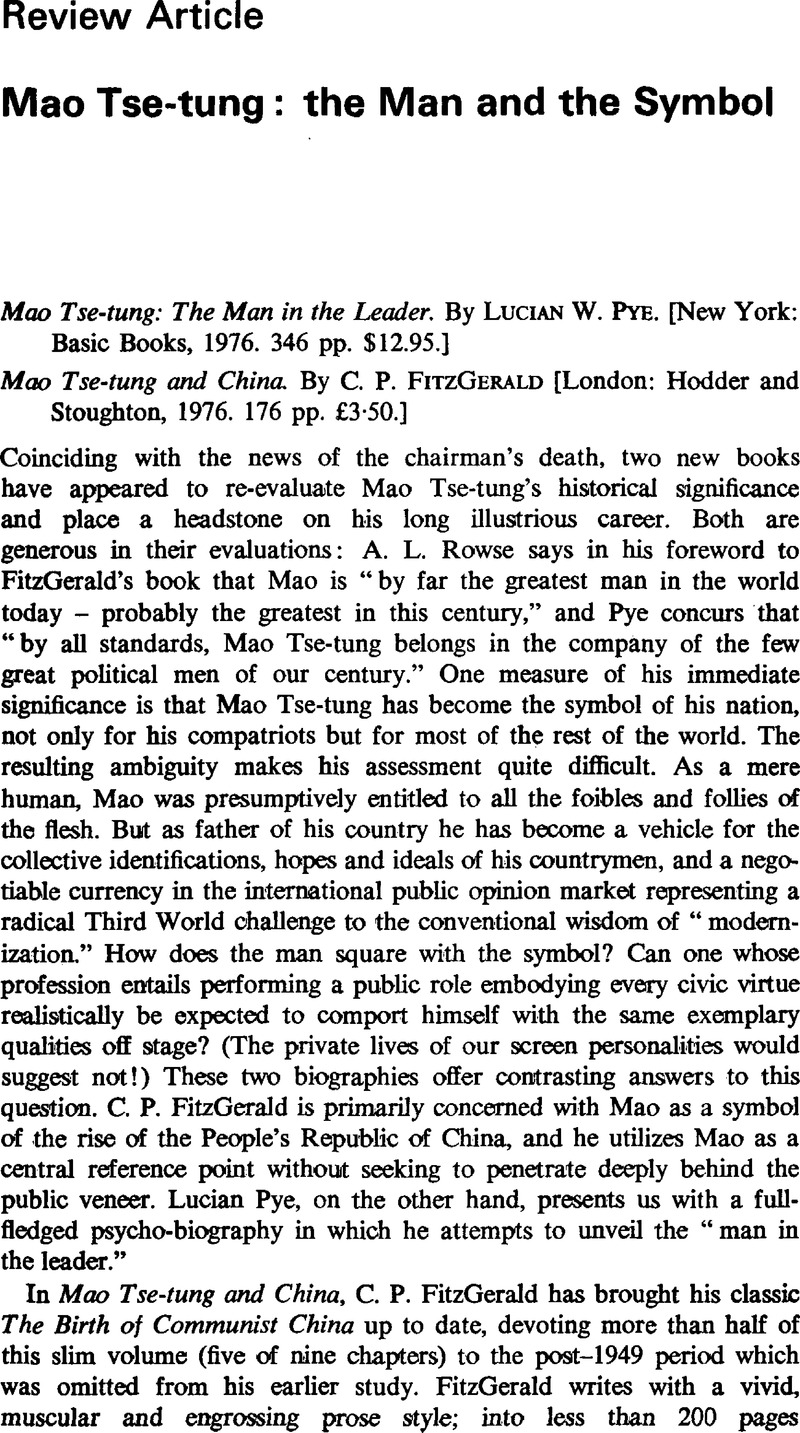No CrossRef data available.
Published online by Cambridge University Press: 17 February 2009

1. Chiang could not end the civil war for fear of legitimating the CCP and thereby providing the Japanese with an anti-Communist pretext for all-out invasion, and the KMT could not hope to withstand such an invasion without resorting to guerrilla warfare, FitzGerald argues. But guerrilla war entails arming the peasants and inspiring them with a reason to fight, presenting great social dangers to the class of small rural landlords upon which Chiang's power rested, FitzGerald, Mao Tse-tung, p. 38.
2. Ch'en, Jerome, Mao (Englewood Cliffs, N.J.: Prentice-Hall, 1969), p. 40.Google Scholar
3. Mazlish, Bruce, The Revolutionary Ascetic (New York: Basic Books, 1976).Google Scholar
4. Friedlander, Saul and Cohen, Raymond, “The personality correlates of belligerence in international conflict: a comparative analysis of historical case studies,”Comparative Politics, Vol. VII, No. 2 (January 1975), pp. 155–87. The psychodynamic explanation of this correlation is that when male children encounter social pressure to behave in a masculine manner in the absence of a masculine role-model, they tend to exhibit compensatory aggressiveness.CrossRefGoogle Scholar
5. Snow, Edgar, Red Star Over China (New York: Grove Press, 1968), p. 95;Google Scholar see also Smedley, Agnes, Battle Hymn of China (New York: Knopf, 1943), pp. 168–70. These sources are cited by Pye, it should be noted, but he reinterprets them.Google Scholar
6. Lane, Robert E. notes in an entirely different context that “a need to be liked which is somehow complicated and restrained by a fear of intimacy tends to work itself out in the form of bidding for the affection of distant groups, safe because they can be seen more as symbols than as persons. What goes into this intimacy complex is another matter, but some element of unacceptable hostility is a very likely ingredient, hardly known to the cook who prepares this dish for his own table.”Political Thinking and Consciousness: The Private Life of the Political Mind (Chicago: Marham, 1969), p. 123. That this observation could be made of an American university student suggests that the underlying motive is both psychologically cogent and fairly widespread.Google Scholar
7. A recent study suggests in fact that Kao Kang was a consistent “Maoist.”Cf. Roy F. Grow, “Soviet industrial strategies and Chinese politics,”paper presented to the 28th Meeting of the Association for Asian Studies, Toronto, Canada, 19–21 March 1976.
8. Some of these alternative conceptions of the power structure are noted in Oksenberg, Michel, “Political changes and their causes in China, 1949–1972,”The Political Quarterly, Vol. XLV, No. 1 (1974), pp. 95–114.CrossRefGoogle Scholar
9. Erik Erikson provides the best synthesis of psychological and sociological interpretations in contemporary biography. See especially his Young Man Luther: A Study in Psychoanalysis and History (New York: Norton, 1962);Google Scholar also Gandhi's Truth: On the Origins of Militant Nonviolence (New York: Norton, 1969).Google Scholar
10. George, Alexander L., “Assessing presidential character”(Review of James David Barber, The Presidential Character: Predicting Performance in the White House), World Pojitics, Vol. XXVI, No. 2 (January 1974), pp. 234–83, esp. p. 245.Google Scholar
11. Pye, Lucian, “Introduction”in Political Culture and Political Development, by Pye, Lucian and Verba, Sidney (eds.) (Princeton, N.J.: Princeton University Press, 1965), p. 9;CrossRefGoogle Scholar see also his article “Political culture”in International Encyclopedia of the Social Sciences (New York: Macmillan and The Free Press, 1968), Vol. XII, pp. 218–25.Google Scholar